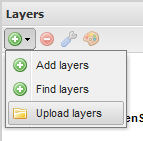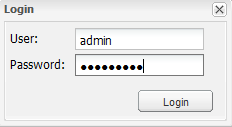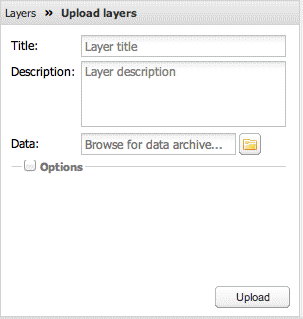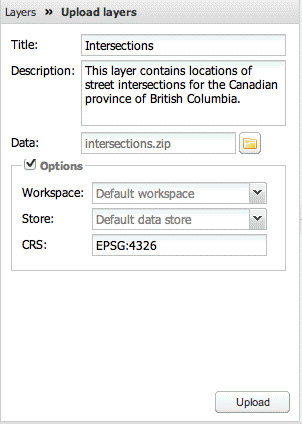Upload Data¶
With GeoExplorer you can upload data, shapefiles (compressed into an archive file) or GeoTIFF files directly into a local instance of GeoServer. The data will be configured and styled automatically to work in GeoExplorer.
Warning
Shapefiles must be in an archive file. Simply selecting the .shp file will not work. Refer to the section on Data formats for more information.
To upload data, you must login to the local GeoServer instance for authentication. For more information, please refer to the Login section.
To access the Upload layers panel, click Add Layers
 on the Layers panel toolbar and click Upload layers.
on the Layers panel toolbar and click Upload layers.
Upload layers tool
If you’re not already logged into the local GeoServer instance, a Login dialog box will be displayed. Enter your GeoServer user name and password.

Login to the local GeoServer
On successful completion of the login process, the Upload layers panel will display.

Upload layers panel
Complete the Upload layers panel.
Field Description Title Layer Title—Human-readable layer headline (as opposed to the ID/Name). If left blank, the Title will be set to [filename]and the ID set to[workspace]:[filename].Description Layer Abstract—Description of the layer. This may span multiple paragraphs if required. Data Data file to be uploaded—Valid file extensions are .zip,.gz,.tar.bz2,.tar,.tgz,.tbz2, or.tif. Click the folder button to display a file select dialog box. See the section on Data formats for more information on what types of data can be uploaded.Click the Options check box to display three additional options.
Field Description Workspace GeoServer workspace to be associated with the layer. Select from any available workspaces. Default is the default workspace in GeoServer. Store GeoServer store where the layer will be stored. Select from any available store. Default is the default store in GeoServer. CRS Coordinate Reference System ID—EPSG spatial reference code (for example, EPSG:4326) 
Completed Upload layers panel
When the Upload layers panel is completed, click Upload to start loading the data.

Uploading and configuring data
The data is processed in the following order:
- File copied to the GeoServer data directory (subfolder named
incoming) - Archive unpacked (if applicable)
- Data loaded as a layer in GeoServer (with your Title and Description assigned)
- Projection for the layer will be determined. If this is not possible (for example, the CRS ID wasn’t supplied when the data was uploaded), the projection information must be supplied separately in GeoServer.
- Unique style created for the layer
After the upload process is complete, you will see your new layer in the Available Layers panel. You can now Add layers to your map.
Data formats¶
The Upload layers panel will accept data in either shapefile or GeoTIFF format. If you are uploading shapefiles, the shapefile must be added to an archive file (zip, tar, gzip, or bzip). (The upload data process requires a single file, and shapefiles include a number of files including, but not limited to, .shp, .shx, and .dbf files.)
A GeoTIFF file (.tif) does not need to be in an archive format, but may be added to an archive file if reducing file size is a requirement.